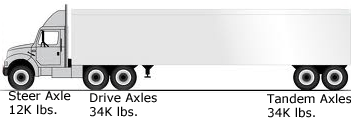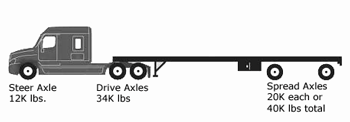Tandem vs Spread Axles the Pros and Cons
Tandem vs spread axles: the pros and cons. The first thing to point out is that the gross legal limit of 80,000 lbs applies to whether you have a tandem or spread axle configuration. However, how the weight is distributed on the axles is one of the primary differences, but not the only difference and there are pros and cons of each.
Tractor Trailer Axles
Tractor Trailer Axles
Tandem Axle Trailer
A tandem trailer can carry 34,000 lbs on the tandem axles and the tandems can be slid forward or backward to adjust how much weight is actually sitting on the tandems. This can be challenging for heavier loads to get the weight correctly balanced when trying to be right at 80k lbs. They are easier on tires and more maneuverable overall.
Spread Axle Trailer
A spread axle trailer can carry 40,000 lbs on the spread axles allowing for more leeway in placing a heavier load. The spread of the two axles is 10’2″ counting them as two separate axles that can each carry 20k lbs. This gives you a legal limit of 86k lbs of all axles. Of course you still have the 80k lbs gross limit, so this gives you a larger margin of error when hauling heavier loads. They are more difficult to back up and are rougher on tires due to the “scrub” of making turns. But this can be offset using the dump on the rear axle. They are a smoother ride in more situations but can be more difficult to maneuver on some roads. California requires that trailers over 48′ long have a kingpin to center of rear axle of 41′ and this can be difficult for spread axle trailers. The rear axle would have to be able to be slid forward to the 41′ length to be legal. Manitoba does not allow spread axle trailers.






